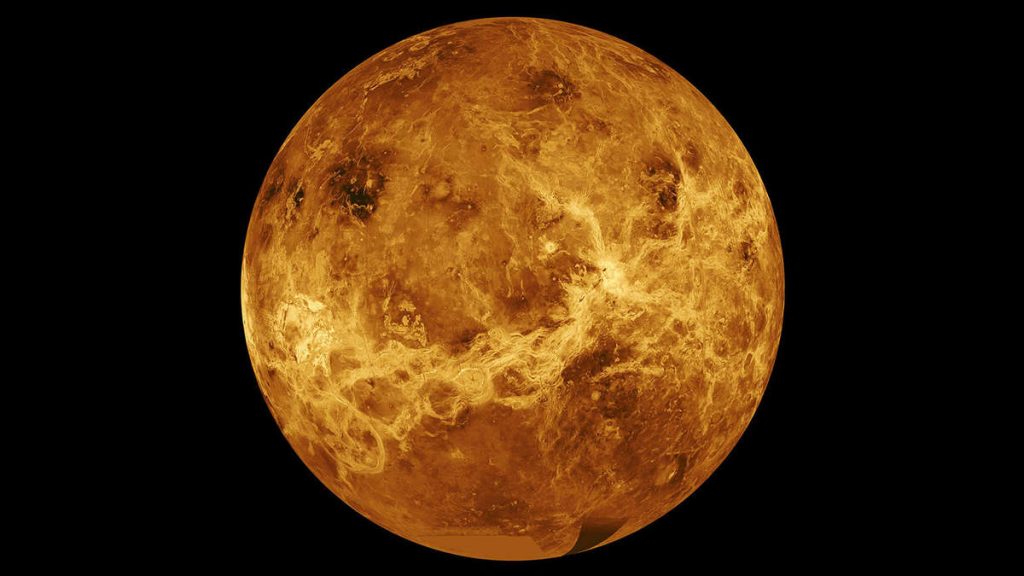-
FromTanya Banner
Close
Current research deals with possible life on Venus – NASA is now planning two missions to explore the neighboring planet Earth.
WASHINGTON/Frankfurt – Venus is similar to Earth in many ways – but on one crucial point the two planets differ greatly from one another: While Earth is friendly to life, the planet next door to it can be described as a glowing inferno, the American space that NASA even talks about A world like hell. However, experts believe it could have been a habitable planet in our solar system, and might even have an Earth-like ocean and climate.
In order to learn more about Earth’s closest neighbors, NASA plans to send two space probes to Venus in the coming years. As part of the “Discovery Program”, the US authorities have selected the DAVINCI+ and VERITAS missions to continue exploring the planet. Space probes are scheduled to leave for the planet’s neighboring planet between 2028 and 2030.
Space Newsletter
No matter if it’s Venus, Mars, the Sun, black holes, galaxies, rockets or satellites – with the FR Newsletter on Astronomy and Space Travel, you can stay up to date with current developments and events.
NASA wants to explore Venus: ‘It’s amazing how little we know’
“It’s amazing how little we know about Venus,” wonders Tom Wagner, a scientist on NASA’s “Discovery Program.” And he asserts: NASA’s two future Venus missions should discover a lot about the planet — from clouds in the sky to volcanoes on the surface to the planet’s core. “It would be as if we rediscovered the planet.”
“We’re kicking off our planetary science program with an intense exploration of a world that NASA hasn’t visited for more than 30 years,” said Thomas Zurbuchen, NASA’s director of science. “We are arriving in a new decade of Venus in order to understand how an Earth-like planet could become a greenhouse,” Zurbuchen explains in a message from NASA. The authority not only wants to understand the evolution of planets and the possibility of habitation in our solar system, but it also wants to extend knowledge to the exoplanets.
Venus still holds many secrets that two future NASA missions must glean from. The image was created from data from NASA’s Magellan and Pioneer Venus Orbiter space probes.
© NASA/JPL-Caltech
Is there life on Venus? The current research likely has to do with the selection of NASA
In recent months, some scientific work on Venus has caused a sensation: with the help of telescopes, researchers have discovered a rare molecule phosphine in the atmosphere of Venus, which is produced in only two ways on Earth: artificially or by microbes that live in oxygen. – Free environment. The research was controversial, but old data from NASA’s Pioneer space probe confirmed the discovery. Planning for the two selected Venus missions was supposed to begin long before these discoveries and had nothing to do with them – but the fact that NASA decided to do two Venus missions at the same time must be related to the current research findings.
| planet: | Venus |
|---|---|
| Distance from the sun: | 108,200,000 km |
| Orbit time around the sun: | 225 days |
| Temperature: | 437-497 °C |
| press: | 92 bar |
| The main components of the atmosphere: | Carbon Dioxide (96.5%), Nitrogen (3.5%), Sulfur Dioxide (0.015%) |
NASA’s DAVINCI+ mission is to explore how Venus’s atmosphere is formed
The DAVINCI+ space probe (Venus’s Deep Atmosphere Exploration of Noble Gases, Chemistry and Imaging) will measure, among other things, how Venus’s atmosphere is formed. This knowledge should help understand how the atmosphere is formed and changed. In addition, researchers should be able to use the data to find out if the planet has an ocean. The space probe’s landing module should plunge into the thick atmosphere of Venus and discover noble gases there, among other things – this data should aid research into why Venus is such a greenhouse.
Moreover, DAVINCI+ is supposed to send the first high-resolution images of a unique geological formation to Earth: “Tesserae” can be compared to Earth’s continents and probably means that there is plate tectonics on Venus. “The DAVINCI+ results could change our understanding of the formation of rocky planets inside and outside our solar system,” NASA says. The spacecraft will be the first US mission into the atmosphere of Venus since 1978. At that time, the “Pioneer” space probe examined Venus.
Astronomy news and news from space travel can be found on our topic pages.
NASA’s VERITAS mission is to map the surface of Venus
The second Venus mission is called VERITAS (Venus Emissivity, Radio Science, InSAR, Topography and Spectroscopy) and aims to map the planet’s surface and also to record the planet’s topography. With the help of this data, researchers should be able to draw conclusions about the geological history of the planet, and thus find out why Venus evolved so differently from Earth. It should also be possible to find out if processes such as the movement of tectonic plates and volcanoes are active on Venus. And Veritas must also answer another question: What rock is Venus made of?
The German Aerospace Center (DLR) also participates in the Venus VERITAS mission: it provides the VEM spectrometer (Venus Emissivity Mapper). (Tania Banner)
Base list photo: © Nasa / JPL-Caltech





More Stories
Nvidia GeForce RTX 4090: AIDA64 gets Ada spearhead support
Rogue Trader – Details about the first cRPG in the series – CD-Action
t3n – Digital Pioneers | digital business magazine